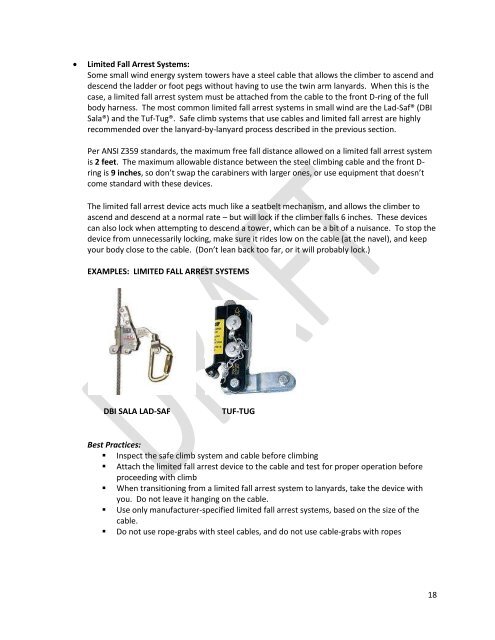Best Practices in Small Wind: Tower Climbing Safety
Best Practices in Small Wind: Tower Climbing Safety
Best Practices in Small Wind: Tower Climbing Safety
Create successful ePaper yourself
Turn your PDF publications into a flip-book with our unique Google optimized e-Paper software.
� Limited Fall Arrest Systems:<br />
Some small w<strong>in</strong>d energy system towers have a steel cable that allows the climber to ascend and<br />
descend the ladder or foot pegs without hav<strong>in</strong>g to use the tw<strong>in</strong> arm lanyards. When this is the<br />
case, a limited fall arrest system must be attached from the cable to the front D-r<strong>in</strong>g of the full<br />
body harness. The most common limited fall arrest systems <strong>in</strong> small w<strong>in</strong>d are the Lad-Saf® (DBI<br />
Sala®) and the Tuf-Tug®. Safe climb systems that use cables and limited fall arrest are highly<br />
recommended over the lanyard-by-lanyard process described <strong>in</strong> the previous section.<br />
Per ANSI Z359 standards, the maximum free fall distance allowed on a limited fall arrest system<br />
is 2 feet. The maximum allowable distance between the steel climb<strong>in</strong>g cable and the front Dr<strong>in</strong>g<br />
is 9 <strong>in</strong>ches, so don’t swap the carab<strong>in</strong>ers with larger ones, or use equipment that doesn’t<br />
come standard with these devices.<br />
The limited fall arrest device acts much like a seatbelt mechanism, and allows the climber to<br />
ascend and descend at a normal rate – but will lock if the climber falls 6 <strong>in</strong>ches. These devices<br />
can also lock when attempt<strong>in</strong>g to descend a tower, which can be a bit of a nuisance. To stop the<br />
device from unnecessarily lock<strong>in</strong>g, make sure it rides low on the cable (at the navel), and keep<br />
your body close to the cable. (Don’t lean back too far, or it will probably lock.)<br />
EXAMPLES: LIMITED FALL ARREST SYSTEMS<br />
DBI SALA LAD-SAF TUF-TUG<br />
<strong>Best</strong> <strong>Practices</strong>:<br />
� Inspect the safe climb system and cable before climb<strong>in</strong>g<br />
� Attach the limited fall arrest device to the cable and test for proper operation before<br />
proceed<strong>in</strong>g with climb<br />
� When transition<strong>in</strong>g from a limited fall arrest system to lanyards, take the device with<br />
you. Do not leave it hang<strong>in</strong>g on the cable.<br />
� Use only manufacturer-specified limited fall arrest systems, based on the size of the<br />
cable.<br />
� Do not use rope-grabs with steel cables, and do not use cable-grabs with ropes<br />
18














